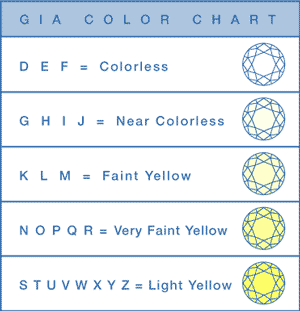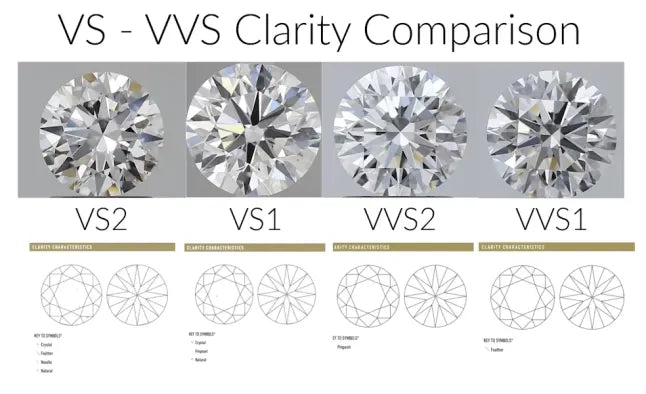Diamonds are born deep within the Earth under immense pressure and heat. This natural process can result in unique birthmarks, known as inclusions and blemishes, which affect a diamond's clarity. Understanding diamond clarity empowers you to appreciate the unique character of each stone and make an informed decision based on your preferences and budget.
Inclusions and Blemishes: Nature's Fingerprints

- Inclusions: These are internal characteristics, such as crystals, clouds, or feathers, that formed within the diamond during its creation.
- Blemishes: These are external imperfections on the diamond's surface, such as scratches, nicks, or extra facets.
Most inclusions and blemishes are microscopic and invisible to the naked eye. However, larger or numerous imperfections can affect a diamond's brilliance and sparkle by interfering with the way light passes through the stone.
The Diamond Clarity Scale
The Gemological Institute of America (GIA) has developed a clarity scale to grade diamonds based on the number, size, nature, position, and color or reflectivity of their inclusions and blemishes. The scale ranges from Flawless (FL) to Included (I):
- Flawless (FL): No inclusions or blemishes are visible under 10x magnification.
- Internally Flawless (IF): No inclusions are visible under 10x magnification, but minor blemishes may be present.
- Very, Very Slightly Included (VVS1 and VVS2): Inclusions are very difficult for a skilled grader to see under 10x magnification.
- Very Slightly Included (VS1 and VS2): Inclusions are minor and difficult for a skilled grader to see under 10x magnification.
- Slightly Included (SI1 and SI2): Inclusions are noticeable under 10x magnification.
- Included (I1, I2, and I3): Inclusions are obvious under 10x magnification and may affect the diamond's transparency and brilliance.
How Clarity Affects Brilliance and Value
A diamond's clarity can influence its brilliance, fire, and scintillation. Inclusions and blemishes can obstruct the path of light, reducing the stone's ability to reflect and refract light. However, the impact of clarity on brilliance is often minimal, especially in higher clarity grades.
Clarity is also a significant factor in determining a diamond's value. Flawless and Internally Flawless diamonds are the most rare and valuable, followed by VVS and VS clarity grades. SI clarity diamonds offer excellent value and brilliance, while I clarity diamonds are the most affordable.
Choosing the Right Diamond Clarity
Selecting the right diamond clarity is a balance between your desired level of perfection and your budget. Here are some factors to consider:
- Eye Cleanliness: Many inclusions and blemishes are invisible to the naked eye. Consider choosing an "eye-clean" diamond, meaning no imperfections are visible without magnification. This can offer excellent value without compromising on beauty.
- Diamond Shape and Size: Some diamond shapes, such as emerald cuts, tend to reveal inclusions more readily. Smaller diamonds also tend to hide imperfections better than larger stones.
- Personal Preference: Some individuals prefer the absolute perfection of flawless diamonds, while others appreciate the unique character of stones with minor inclusions. Consider your personal preferences and priorities.
- Budget: Higher clarity grades command higher prices. Consider setting a budget and exploring the clarity options available within your price range.
Tips for Evaluating Diamond Clarity
- View Diamonds Under Magnification: Use a jeweler's loupe or microscope to examine the diamond under 10x magnification. This will allow you to see any inclusions or blemishes and assess their size and location.
- Consult a Reputable Jeweler: A knowledgeable jeweler can explain the nuances of diamond clarity and help you understand the GIA clarity scale. They can also point out any inclusions or blemishes and discuss their potential impact on the diamond's brilliance.
- Review the Diamond Certificate: Always request a diamond certificate from a reputable grading laboratory, such as GIA or IGI. This certificate provides an unbiased assessment of the diamond's clarity and other characteristics.
Conclusion
Diamond clarity is a captivating aspect of these precious gemstones. By understanding the clarity scale, how clarity affects brilliance and value, and the factors to consider when choosing a diamond, you can confidently select a stone that reflects your individual preferences and budget. Whether you're drawn to the absolute perfection of a flawless diamond or the unique character of a stone with minor inclusions, your diamond will be a cherished symbol of your discerning taste and enduring love.






